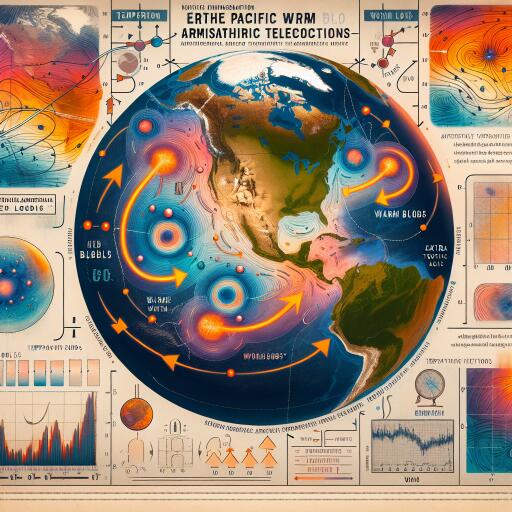
Northeast Pacific Warm Blobs Linked to Atmospheric Phenomena Far Beyond Its Shores
An intriguing phenomenon, known as the “warm blobs” in the Northeast Pacific (NEP), has puzzled scientists for years. These areas of significantly warmer sea surface temperatures have profound effects on marine ecosystems and weather patterns across North America. New research sheds light on the complex atmospheric interactions that sustain these warm blobs, pointing to a significant influence from atmospheric conditions over the North Atlantic and the Mediterranean Sea.
Warm blobs are most prevalent during the colder months, from November to March. They emerge under a persisting ridge—an area of high atmospheric pressure—above the NEP. This ridge plays a crucial role in the formation and maintenance of warm blobs, altering the typical climate and ocean patterns in the region.
The development of these ridges ties back to atmospheric conditions thousands of miles away. Specifically, wave trains—long, undulating movements of air—originating from the North Atlantic and branching out from the Mediterranean area, propel energy across continents and oceans, culminating in the NEP’s persistent ridge.
These atmospheric wave trains are shaped by Rossby waves, which are large movements of air that occur due to Earth’s rotation. The study highlights how these Rossby waves travel along the jet streams, channels of fast-flowing air high in the atmosphere. Interestingly, the interaction between two distinct wave trains—one following the subtropical jet and the other along the subpolar jet—near Japan appears to play a critical role in enhancing the ridge over the NEP.
Further investigation reveals that regions of Rossby wave emission—areas where these waves are generated—are heavily influenced by contrasting rainfall patterns. Notably, significant rainfall anomalies in the North Atlantic and Mediterranean regions coincide with the emission of Rossby waves that eventually amplify the NEP ridge. The study finds that these rainfall anomalies are closely linked with the phase of the North Atlantic Oscillation, a climatic phenomenon that influences weather patterns across the Northern Hemisphere.
The role of rainfall in these processes cannot be understated. Regions experiencing above-average rainfall, such as the Mediterranean during certain years, see a surge in Rossby wave activity. This dynamic suggests a direct connection between localized weather events and broader atmospheric patterns that affect ocean temperatures halfway across the globe.
To understand the mechanics behind these interactions, researchers have turned to models simulating the effects of anomalous heating and cooling in these critical regions. These models confirm the significant impact of atmospheric conditions over the Mediterranean and the North Atlantic in forming the anomalous ridge over the NEP. Moreover, they offer insights into how variations at the surface level, such as changes in sea surface temperatures and rainfall, can have far-reaching effects on atmospheric dynamics.
This research not only deepens our understanding of the atmospheric phenomena contributing to the NEP’s warm blobs but also highlights the interconnectedness of our planet’s climate system. Events in one part of the globe can influence weather and ocean patterns thousands of miles away, illustrating the complexity and interdependence of Earth’s climate.
By uncovering the extratropical teleconnections underlying the NEP warm blobs, scientists are better equipped to predict these events and understand their broader ecological and climatic impacts. This knowledge is crucial for developing strategies to mitigate the effects of climate change and protect vulnerable marine ecosystems affected by these warm water anomalies.





Leave a Reply